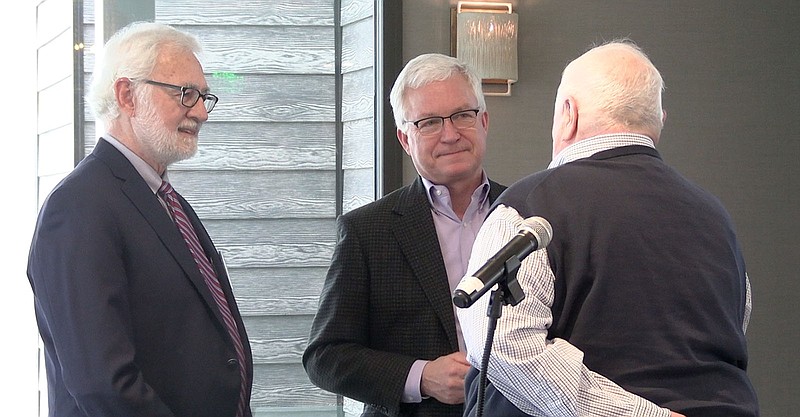It's been nearly three years since the U.S. began to implement shutdowns on March 15, 2020, in order to prevent the spread of COVID-19.
"I'd like to ask you to think about where you were three years ago and how that first few weeks impacted you, your family, your social circles, your job," Dr. Joe Thompson, president and CEO of the Arkansas Center for Health Improvement, said to members of the Hot Springs National Park Rotary Club on Wednesday.
"I'd also like to congratulate you. You have survived a worldwide pandemic. There are not many generations, except for 110 years ago, that could say that," he said.
Video not playing? Click here https://www.youtube.com/embed/cRpMjq-I41U
Thompson asked the Rotary Club members to take a moment of silence for those who did not survive the pandemic, including the 13,000 Arkansans, 1.1 million Americans and 6 million people across the world.
The first case of COVID-19 was identified in Wuhan, China, in December 2019. In January 2020, the U.S. confirmed its first positive case from the state of Washington. Arkansas confirmed its first positive case on March 11, 2020.
States implemented shutdowns and restrictions across the country. Some believed the restrictions were placed to protect people from getting the virus altogether. However, Thompson said the goal of the restrictions was to keep the hospitalizations at a manageable rate.
"Our goal originally was to keep from overwhelming our health care system," he said. "I don't think most people realize if we'd had this spike of cases early on, we didn't have the bed capacity or the ventilator capacity or the personnel capacity, and so this was our original goal.
"We have infections each year from pneumococcal disease, but enough of us have had exposure to those that we don't all get infected at the same time. And with COVID, because it was a new virus that none of our immune systems had ever seen, was a threat, and it was very, very infectious. It spread quickly. And for some, it was very, very harmful. It caused major illness. There was the real threat that we could overwhelm our health care system, and I think a success is that we did not, in general, do that."
The virus reached larger international cities first, and then reached large urban areas, such as capital cities. Finally, it took longer to reach rural parts of America, causing "some political challenges on messaging," Thompson said.
"You know, what the risk was, what we needed to do. And we took action, but sometimes our action wasn't necessarily temporarily aligned with where the threat was, and so that generated energy that some people exploited for their personal or political game."
However, Arkansas "took a little different path," he said, commending former Gov. Asa Hutchinson and his adviser, Dr. Nate Smith, an infectious disease physician.
"Other states, you remember, did kind of a blanket executive order, shutting everything down," he said. "Our state went kind of a phase level in, shutting things down that made sense on the path as the risk presented itself. What that let us do is we unwound those shutdowns (and) gradually come off of it as opposed to some states that did everything all at once, then they had to undo everything all at once."
By May 2020, some of those restrictions were starting to lift, including the conditional return of gyms, cosmetologists and commercial lodging, he said.
After successfully avoiding the overwhelm of the health care system, the next issue was figuring out how to start combating the virus. More than one-third of America's population is known to have been infected, Thompson said.
"I expect most of us have been exposed at one time or another," he said. "Many of us probably had been infected but didn't get symptomatic and therefore, we have, you know, built some immunity."
While there was no way to cure or prevent the virus for a long time, there were many experimental solutions that have now been proven ineffective, including giving a newly infected person antibodies from someone who was previously infected, called intravenous immunoglobulin or IVIg.
"We've done that with other conditions," he said. "We tried it with COVID. It did not seem to work, and so we abandoned that after a period of time.
"Now, we do have Paxlovid, which is an antiviral drug that is effective at keeping you out of the hospital or avoiding some of the worst outcomes. It may not keep you from getting sick, but it is highly correlated with keeping you from having a bad outcome."
Vaccine manufacturers had already developed messenger RNA vaccines for Ebola and other rare conditions, he said. This is why a vaccine for COVID-19 was turned around so quickly, by sequencing the RNA of the virus's spike protein and helping to block the attachment of the virus to the person's cells.
Even three years later, although there aren't as many restrictions, the threat still exists. New variants continue to mutate, potentially posing a different risk than the last.
"We have survived a pandemic," Thompson said. "We're getting back to our new normal. It is different. It is new. We're reconnecting. We're regenerating, you know, community engagement. We've got new tools, like Zoom. ... As we go into this spring period, I do think it's a time for rejuvenation. It is a time for reflection.
"There's a lot of rhetoric going down about what we will and what we won't do in the future. I will just tell you this was a worldwide threat. We need to keep all our tools on the table in case we need to use them, and we need to be thoughtful about what we've experienced and learn from it."
